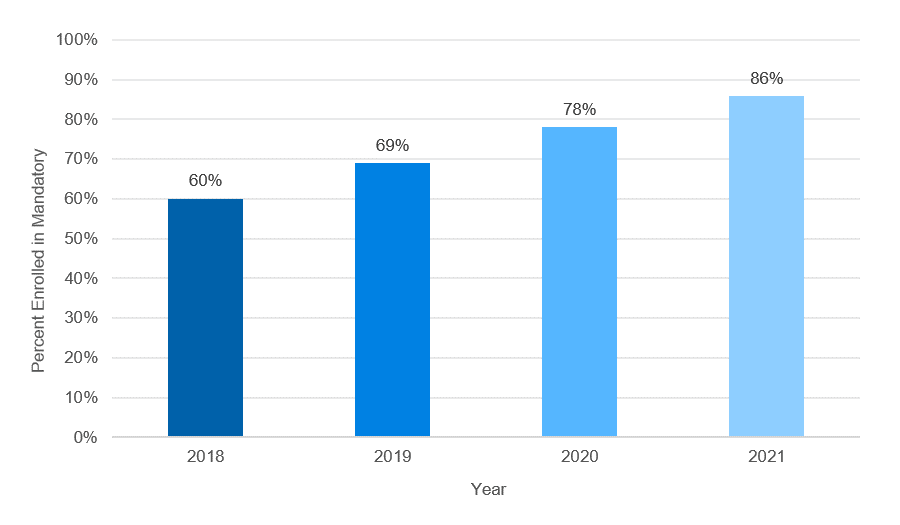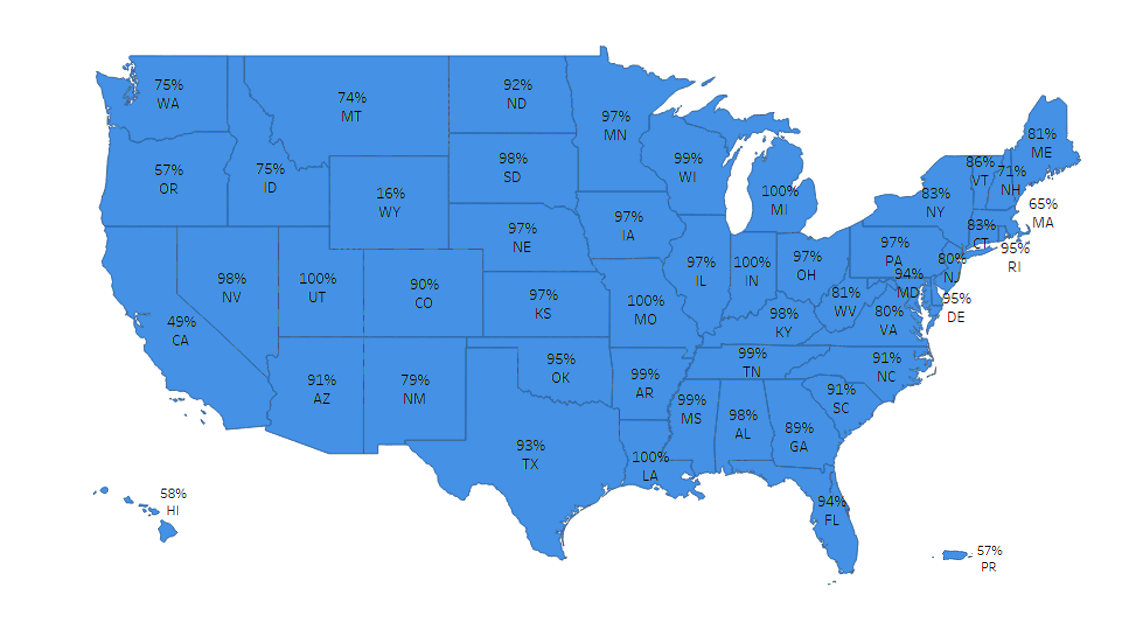In recent proposed legislation, Medicare Expansion Bill H.R. 3 was passed in 2019 by the House of Representatives and has been discussed by the Senate. This bill focuses on reducing prescription drug costs in the Medicare program, and the savings would be reinvested into expanding benefits for dental, vision, and hearing under Medicare Part B.3 In addition, the House is considering modifications to H.R. 3 as part of a larger budget proposal. At this time, the specifics of the bill are still being negotiated.
There are different options for MA beneficiaries if they are interested in dental benefits. The benefits can be mandatory or optional. A mandatory dental benefit is embedded in the MA plan as a supplemental benefit, and the MA plan can either have a nonzero premium or have a zero premium. An optional dental benefit is a separate purchase decision by the beneficiary and the member pays an additional rider premium. Additionally, MA beneficiaries can purchase separate supplemental dental insurance to either have dental coverage or to improve the benefits already offered in the MA plan.
Dental coverage may include preventive services only, or both preventive and comprehensive services. Preventive dental benefits are those that help maintain good oral health and usually have lower costs. Comprehensive dental benefits are more specialized and usually have a higher cost. These include prosthodontics, restorative services, and extractions.
This article provides an overview of dental benefits within MA plans based on 2021 Centers for Medicare and Medicaid Services (CMS) data and analyzes how the benefits, enrollment, and trends have changed since 2018. The number of individuals enrolling in MA plans including mandatory dental is increasing year over year, which may be impelling MA plans to change what benefits they offer in order to stay competitive. Monitoring the dental benefits that are most popular and forming conclusions as to why some beneficiaries are switching from some plans to others will help MA organizations understand their consumers better.
MA mandatory and optional dental enrollment trends
Enrollment in MA plans with mandatory dental benefits, with either preventive only or both preventive and comprehensive benefits, has been growing consistently since 2018. The percentage of individuals enrolled in MA plans whose plans include mandatory dental benefits has increased from 60% in 2018, to 69% in 2019, to 78% in 2020, and finally to 86% in 2021. MA beneficiaries appear to see the value of getting dental benefits through their MA plans instead of choosing to purchase it on their own. This could be due to the convenience of only having to research and enroll in one plan, rather than also having to search for a dental plan.
FIGURE 1: ENROLLMENT IN PLANS WITH MANDATORY DENTAL BENEFITS

Looking across states, we see that enrollment in MA plans with mandatory dental benefits is increasing across the board. In the past, there were no states with 100% of their MA plan enrollees enrolled in plans with mandatory dental. For 2021, there are six states or districts with 100% enrollment in plans with mandatory dental benefits: the District of Columbia, Indiana, Louisiana, Michigan, Missouri, and Utah (see Figure 2). Last year, there were fewer than 20 states with more than 90% of MA enrollees in plans with mandatory dental coverage; this year there are over 30, which shows that enrollment in MA plans with mandatory dental benefits is indeed growing in popularity.
The percentage of enrollees in MA plans with mandatory dental coverage who receive common benefits like x-rays and oral exams remained consistently over 80%. There was a slight increase in enrollment in plans with a fluoride benefit, with over 60% of enrollees in MA plans with this coverage.
While enrollment in MA plans with mandatory dental benefits has increased, enrollment in MA plans with optional dental benefits has decreased. In 2021, 86% of all MA plan enrollment was in plans with mandatory dental benefits, while only 37% of all MA plan enrollment was in plans with optional dental benefits. Perhaps MA plans are including more in their mandatory benefits, therefore making it unnecessary for members to enroll in plans with optional dental benefits. Enrollment in MA plans with optional benefits such as x-ray services, oral exams, prophylaxis, and fluoride all decreased approximately 5% from last year.
FIGURE 2: PERCENTAGE OF TOTAL MA PLAN ENROLLMENT IN PLANS WITH MANDATORY DENTAL BENEFITS4
Preventive and comprehensive dental benefit trends
Within the universe of MA plans that include mandatory dental coverage, enrollment in plans including both preventive and comprehensive dental benefits (rather than just preventive) has been increasing since 2018. In 2018, enrollment in MA plans including both preventive and comprehensive dental was relatively low at 37%; it increased to 48% in 2019 and then jumped to 60% in 2020 and 71% in 2021.
For plans with both preventive and comprehensive dental benefits, covered services stayed fairly consistent between 2020 and 2021, with the exception of nonroutine services, endodontics, and diagnostic services. Plans including these three services saw large increases in enrollment for both zero premium and nonzero premium MA plans. Plans covering nonroutine services, which include cosmetic procedures and other less commonly covered procedures, increased by about 4% for zero premium plans and 8% for nonzero premium plans. Enrollment in plans covering endodontics, which include services such as root canals, increased approximately 7% in zero premium plans and 13% in nonzero premium plans. The largest increase in enrollment was observed in plans covering diagnostic services: roughly 16% for zero premium plans and 33% for nonzero premium plans. This could be due to a data issue impacting enrollment in 2020. In 2019, enrollment in plans with diagnostic services, which include oral evaluations and cleanings, was 46%, but in 2020 it dropped to 29% and then jumped to 62% for 2021. We are unable to ascertain whether the decrease in 2020 was real or due to a data reporting issue; regardless, the two-year trend in enrollment in plans with diagnostic services is significantly positive.
FIGURE 3: PERCENTAGE OF MA-WITH-PREVENTIVE-AND-COMPREHENSIVE-DENTAL ENROLLMENT IN PLANS WITH VARIOUS COVERED SERVICES: 2020 VS. 2021
| Category | Zero Premium Plans | Nonzero Premium Plans | ||
|---|---|---|---|---|
| 2020 | 2021 | 2020 | 2021 | |
| Prosthodontics | 75% | 75% | 79% | 80% |
| Nonroutine Services | 48% | 52% | 58% | 66% |
| Diagnostic Services | 41% | 57% | 29% | 62% |
| Restorative Services | 94% | 92% | 94% | 93% |
| Endodontics | 49% | 56% | 61% | 74% |
| Periodontics | 71% | 70% | 75% | 82% |
| Extractions | 80% | 78% | 80% | 84% |
Methodology
The Milliman Medicare Advantage Competitive Value Tool (MACVAT®) was used to compare 2021 MA dental enrollment and trends to those of the past few years. Medicare-Medicaid plans (MMPs), employer group waiver plans (EGWPs), Program of All-Inclusive Care for the Elderly (PACE) plans, Part B-only plans, Cost plans, and Medicare Medical Savings Account (MSA) plans were excluded. For this paper, the dental plans with mandatory benefits includes all plans with dental cost sharing and plans that offer preventive benefits, as well as plans that offer both preventive and comprehensive benefits. Plans classified as having preventive and comprehensive benefits offer at least one of the following benefits: prosthodontic, nonroutine, diagnostic, restorative, endodontic, periodontic, and extraction services.
Comparisons to the 2018-2020 period were made based on values from our articles and analyses from prior years.5
What’s next
Even with the COVID-19 public health emergency, the trends in the 2021 dental market landscape have generally stayed consistent with a few exceptions. Overall, enrollment in MA plans with mandatory dental benefits with either preventive only or both preventive and comprehensive benefits continue to increase.
Enrollment in plans that offer particular benefits such as fluoride and diagnostic services saw larger increases, due to either more plans offering those services or more consumers seeking plans that cover them. More plans offering services such as fluoride or diagnostics tend to make the market more competitive, because it is likely that consumers will be drawn toward the plans that offer more benefits. Plans that choose not to offer these same benefits may fall behind and lose members. It is also possible that consumers are becoming more knowledgeable and are actively seeking plans with more service offerings. This translates to members wanting to get the most out of their dental plans, whether they are mandatory or optional; preventive, or both preventive plus comprehensive.
Another future consideration as time goes on is new legislation. With a new administration and upcoming discussions on bills, like H.R. 3, there are endless possibilities as to the changes that could be made in the Medicare world, as well as the benefits within it. We will continue to follow these trends as new data becomes available.
1Kaiser Family Foundation (2020). Total Number of Medicare Beneficiaries. Retrieved September 19, 2021, from https://www.kff.org/medicare/state-indicator/total-medicare-beneficiaries/?currentTimeframe=0&selectedDistributions=original-medicare--total&selectedRows=%7B%22wrapups%22:%7B%22united-states%22:%7B%7D%7D%7D&sortModel=%7B%22colId%22:%22Location%22,%22sort%22:%22asc%22%7D.
2Freed, M., Damico, A., & Neuman, T. (January 13, 2021). A Dozen Facts About Medicare Advantage in 2020. Retrieved September 19, 2021, from https://www.kff.org/medicare/issue-brief/a-dozen-facts-about-medicare-advantage-in-2020/.
3The full text of the H.R. 3 legislation is available at https://www.congress.gov/bill/116th-congress/house-bill/3.
4Alaska is excluded as there are no MA plans available in that state.
5For the 2018 article, see: https://us.milliman.com/en/insight/dental-coverage-in-medicare-advantage-plans-nationwide-market-landscape. For the 2019 article, see: https://www.milliman.com/en/insight/dental-coverage-in-medicare-advantage-plans-nationwide-market-landscape-2019-update. For the 2020 article, see: https://www.milliman.com/en/insight/Dental-coverage-in-Medicare-Advantage-plans-Nationwide-market-landscape-2020-update.
